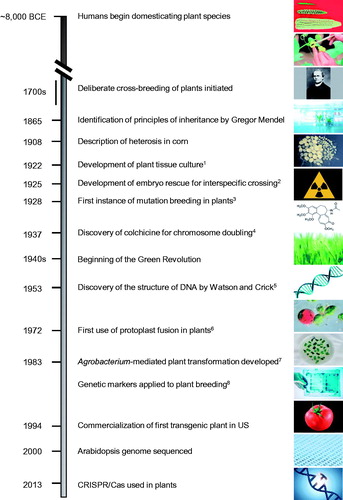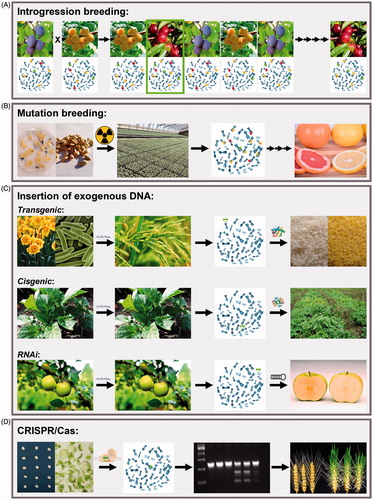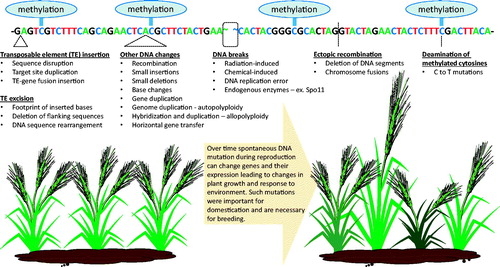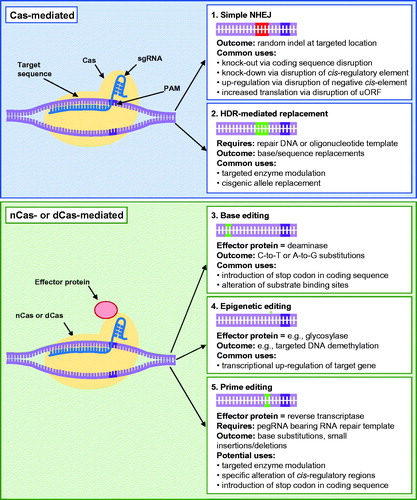Figures & data
Figure 1. Timeline of major events in crop breeding. BCE, Before the Common Era; CRISPR/Cas, clustered regularly interspaced short palindromic repeats/CRISPR-associated protein; DNA, deoxyribonucleic acid; US, United States. References: 1Robbins, Citation1922; 2Laibach, Citation1925; 3Stadler, 1928 b; 4Blakeslee and Avery, Citation1937; 5Watson and Crick, Citation1953; 6Carlson et al., Citation1972; 7Caplan et al., Citation1983; 8Burr et al., Citation1983. Image sources: corn, John Doebley; hand pollination, tissue culture, wheat field, DNA fingerprinting, DNA sequence, and gene editing obtained from iStock; Gregor Mendel, wikipedia; wheat embryos, Andriy Bilichak, Agriculture and Agri-Food Canada; radiation, colchicine and double helix obtained from pngegg.com; protoplasts, Mnolf; petri dish, Udaya Subedi, Agriculture and Agri-Food Canada – Dr. Stacy Singer; tomato, pngfuel.com.

Figure 2. Schematic representation of common plant breeding techniques. A) Introgression breeding involves the crossing of two plant genotypes, the selection of offspring with a desirable trait, and multiple rounds of backcrossing. B) Mutation breeding involves the treatment of plant tissue with physical or chemical mutagens, selection of a genotype with a desirable trait from a large mutagenized population, and multiple rounds of backcrossing. C) Transgenic, cisgenic and RNAi approaches involve the insertion of an exogenous sequence of DNA into the plant genome, which results in the production of either a protein or double-stranded RNA molecule, and consequently the improved trait. D) Simple NHEJ-based CRISPR/Cas gene editing involves the introduction of Cas and sgRNA into plant cells, resulting in a double stranded DNA break at the target site and the subsequent generation of an indel at a precise genomic location, which leads to trait improvement. CRISPR/Cas, clustered regularly interspaced short palindromic repeats/CRISPR-associated protein; DNA, deoxyribonucleic acid; RNAi, ribonucleic acid interference. Image sources: plums, apricots, grapefruit, daffodils, bacteria, rice plant, potato plant, and apple tree obtained from Pixabay; radiation, scissors, proteins, double helix and Cas obtained from pngegg.com; pluots, dreamstime; chromosomes, iStock; callus on media, Udaya Subedi, Agriculture and Agri-Food Canada – Dr. Stacy Singer; citrus seeds, pixnio.com; greenhouse, Government of Newfoundland and Labrador, Department of Fisheries, Forestry and Agriculture; Golden Rice, Golden Rice Project (www.goldenrice.org.); potato blight, Ronald Hutten, Laboratory of Plant Breeding, Wageningen University – Dr. Henk Schouten; nonbrowning apple, webcomicms.net; wheat immature embryos, derived from Hayta et al., Citation2019; protoplasts, Mnolf; gel image, Agriculture and Agri-Food Canada – Dr. Stacy Singer; edited wheat, National Agriculture and Food Research Organization and Okayama University (for more information, please refer to the following article: https://doi.org/10.1016/j.celrep.2019.06.090).

Figure 3. Means by which DNA mutations are incurred spontaneously in plants. Although many naturally occurring mutations have no observable effect on plant growth and appearance, some do, and it is these that are important for plant adaptation and the breeding of new crop cultivars using traditional techniques. DNA, deoxyribonucleic acid; TE, transposable element.

Table 1. Examples of approximate ranges in genetic variability derived spontaneously and from various breeding methods as determined by whole genome sequencing in rice and Arabidopsis.
Figure 4. CRISPR/Cas applications in plants that do not require the extended presence of a transgene. Red base pairs denote random indel mutations at the targeted site, whereas green base pairs represent specific alterations made at targeted loci. Cas, CRISPR-associated protein; dCas, catalytically dead Cas; DNA, deoxyribonucleic acid; HDR, homology-dependent repair; nCas, Cas nickase; NHEJ, nonhomologous end-joining; PAM, protospacer adjacent motif; pegRNA, prime editing guide RNA; RNA, ribonucleic acid; sgRNA, single guide RNA; uORF, upstream open reading frame.

Table 2. Examples of CRISPR/Cas-mediated improvement of various traits in crop species through targeted gene disruption via the generation of NHEJ-derived indels.
